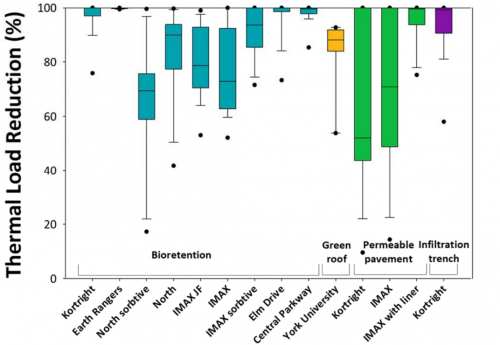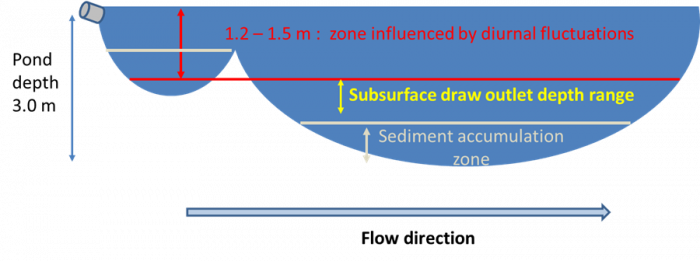Difference between revisions of "Stormwater Thermal Mitigation"
| Line 100: | Line 100: | ||
==Cooling Trenches== | ==Cooling Trenches== | ||
Cooling trenches typically consist of one or more geotextile wrapped perforated pipes embedded in a clear stone filled trench that is buried underground. Water temperatures are reduced through heat transfer from the water passing through the trench to the stone and surrounding soils. Cooling trenches may be installed downstream of the primary pond outlet or draw from a secondary orifice controlled outlet draining water from the pond at or below the permanent pool water level (e.g Van Seters and Graham, 2013; TRCA, 2020). https://sustainabletechnologies.ca/home/urban-runoff-green-infrastructure/thermal-mitigation/thermal-mitigation-system-evaluation/ | Cooling trenches typically consist of one or more geotextile wrapped perforated pipes embedded in a clear stone filled trench that is buried underground. Water temperatures are reduced through heat transfer from the water passing through the trench to the stone and surrounding soils. Cooling trenches may be installed downstream of the primary pond outlet or draw from a secondary orifice controlled outlet draining water from the pond at or below the permanent pool water level (e.g Van Seters and Graham, 2013<ref> Van Seters, T., Graham, C. 2013. Evaluation of an Innovative Technique for Augmenting Stream Baseflows and Mitigating the Thermal Impacts of Stormwater Ponds. Sustainable Technologies Evaluation Program, Toronto and Region Conservation Authority, Toronto, Ontario. https://sustainabletechnologies.ca/app/uploads/2013/08/Cooling-trench-final-2013a.pdf</ref>.; TRCA, 2020<ref>Toronto and Region Conservation Authority (TRCA) 2020. Evaluation of a Thermal Mitigation System on the Heritage at Victoria Square Pond in Markham. Toronto and Region Conservation Authority, Vaughan, Ontario. https://sustainabletechnologies.ca/app/uploads/2021/01/TM-Heritage-report-2021R.pdf</ref>). Further information about these innovative cooling trench features installed as part of the stormwater pond | ||
operation design in two sites located in Markham, ON. visit the [https://sustainabletechnologies.ca/home/urban-runoff-green-infrastructure/thermal-mitigation/thermal-mitigation-system-evaluation/ STEP project page]. The permanent pool of stormwater management ponds acts as a heat sink during the summer, resulting in warmer summer discharges during both storm and baseflow conditions. | |||
The technology, known as the Groundwater Emulation Management System (GEMS), was designed to maintain cool stream discharge from the SWM pond catchment at a level similar to that experienced prior to development. This is accomplished by draining water at a controlled rate from the permanent pool of a stormwater pond to a cooling/infiltration trench. The cooling trench lowers the temperature of pond water through below ground heat transfer and discharges to the receiving watercourse at a rate and volume mimicking the natural discharge of groundwater. Estimated reductions in groundwater recharge caused by the conversion of land from agriculture and open space to residential use provided the basis for setting continuous flow rates released into the system. | |||
[[File:Rock pad energy dissipator.PNG|450px|thumb|An energy dissipater, also known as a "bed friction outlet" that utilizes coarse rip-rap or jagged concrete blocks to ford a rough bed to help slow higher velocity flows leaving the feature. By increasing the roughness of the dissipator the flow of water is spread out, energy is decreased and as a result reduces the chance of downstream erosion or bed scour.<ref>Catchments & Creek Pty Ltd. 2010. Energy Dissipaters, Drainage Control Technique. ED-1.doc. Version 2 - May 2010. International Erosion Control Organization (IECO), Australia. https://www.austieca.com.au/documents/item/307</ref>]] | |||
===Design Considerations=== | |||
*Built-in overflows bypass high flows to help enhance thermal function and prevent excessive sediment build-up in the trench. | |||
*Available research shows that the trench storage volume should be equal to or greater than 5% of the runoff volume discharged from the pond during the 25 mm event. Trenches with smaller storage volumes cannot be relied on to provide any cooling benefits, although under favourable conditions, these may still provide some cooling. | |||
*Flush-out pipes, high flow bypasses and sediment pre-treatment mechanisms should be provided to reduce maintenance. | |||
*Pre-treatment filters, energy dissipators or isolator rows are useful to improve overall functionality but will require regular inspection and maintenance to ensure they are fulfilling their intended function. | |||
*Secondary pond outlets that drain water from 0.5 m below the permanent pool elevation to cooling trenches can help to reduce or eliminate the long duration and very warm interevent flows. | |||
*Trenches may incorporate an infiltration function to help further reduce thermal loads if native soils and groundwater levels are suitable. | |||
===Expected Performance=== | |||
*Performance of primary outlet cooling trenches is highly variable due to differences in cooling trench sizing, design, initial water temperature and degree of groundwater interaction | |||
*Based on case studies reviewed, primary outlet trenches without groundwater interaction may provide summer temperature cooling of the warmest flows by roughly 1 to 3⁰C if the trench storage volume is equal to or greater than 5% of the runoff volume discharged from the pond during the 25 mm event. | |||
==References== | ==References== | ||
Revision as of 19:54, 13 April 2022
Overview[edit]
Streams draining urban areas are often much warmer than those draining natural ones due to changes in surface cover and hydrology. Urbanization increases stream temperatures by decreasing riparian shading and replacing natural landscapes with hard, dark-coloured pavements and roofs that absorb and store heat from the sun. The added impervious cover increases the volume of heated runoff while at the same time reducing discharge of cool groundwater to streams. This heating effect is further exacerbated as runoff flows through stormwater management ponds or other impoundments, where detained water is exposed to solar warming for extended time periods between rain events. This page explores different techniques for mitigating the effects of urbanization on the stream thermal regime.
Thermal Load[edit]
Since stream warming is influenced by the runoff temperature and volume of runoff draining to streams, impacts are best assessed through an evaluation of thermal loads both in the stream and in runoff discharged to streams. The thermal load is a function of the flow rate, water temperature, water density and heat capacity of water (or the energy required to increase a kg of water by 1 degree C).
Thermal Load = Q x ρ x T x C
Where:
- Q = flow rate (m3/s)
- ρ = water density (1000kg/m3)
- T = water temperature (°C)
- C = heat capacity of water (4187J/kg°C)
Since urban runoff volumes often increase by 2 to 5 times after development, and stormwater pond effluent temperatures are between 4 and 11°C warmer than pond influent temperatures in the summer, the overall thermal load increases to streams can be very significant (Van Seters et al. 2019).[1]
Temperature Target Selection[edit]
Setting a stream temperature threshold for the protection of aquatic life can be based on:
- Matching the water temperature regime of either a known pre-development thermal condition or the thermal condition of an undisturbed stream with similar characteristics; and,
- Meeting the upper tolerance of one or more target aquatic species.
Thermal Mitigation Techniques[edit]
Techniques for mitigating thermal impacts to streams can be implemented:
- Within the catchment near the source of runoff,
- Along the conveyance route to a treatment facility
- Within the stormwater pond or other stormwater treatment facility; and/or,
- Within the stream itself.
Upstream of the Pond[edit]
Any measure that decreases runoff volumes or temperatures or both can help mitigate thermal loads to streams or downstream treatment facilities. Examples include bioretention, infiltration trenches or chambers, enhanced swales, permeable pavements, absorbent landscaping and increased canopy cover. The temperature (event mean temperature) and thermal load benefits of the practices are shown in figures 1 to 3 below. The most effective practices were deeper systems such as trenches, some deep bioretention facilities, and practices that promote significant runoff volume reductions. Beyond reducing temperatures and runoff volumes, enhancing infiltration also helps re-establish the natural baseflow regime that existed prior to development.
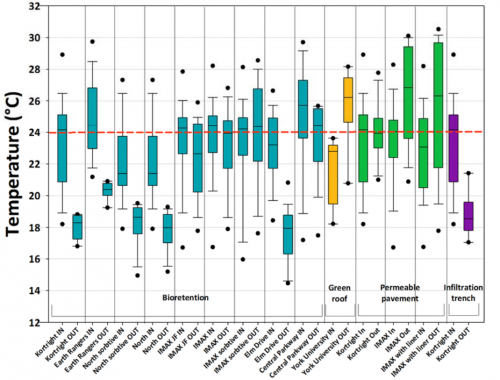

Within the Pond Block[edit]
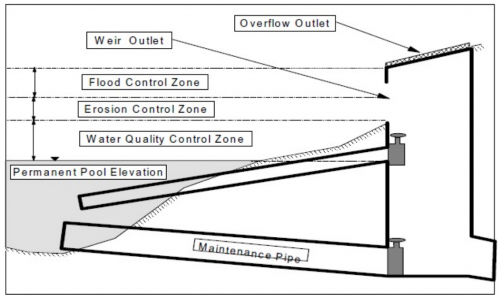
There are several opportunities to mitigate thermal impacts both within the pond itself and/or implemented within the upstream drainage area (and the lands surrounding) of the pond. Options shown in past studies to provide appreciable thermal mitigation benefits include (Van Seters and Dougherty, 2019)[6]]]
Subsurface Draw Outlets[edit]
A reverse sloped outlet pipe drains cooler water from below the pond surface to a control manhole that is accessible from the bank for ease of maintenance. Deeper outlet result in cooler outflows than shallow outlets because pond water temperatures decrease with depth. The figure below shows an example of thermal stratification during the summer in a deep pond using said subsurface outlets.
Design Considerations[edit]
- Subsurface outlet inverts should be a minimum 1.2 m below the permanent pool water level to avoid influence from solar induced diurnal fluctuations.
- Subsurface outlets need to elevated from the pond bottom by between 1 and 1.5 m to allow space for sediment to accumulate. Reducing the separation distance may mean that the pond will need to be cleaned prior to its normal life cycle maintenance schedule, as per MECP guidance (link to our stormwater inspection and maintenance guide).
- Meeting outlet to bottom separation requirements by over excavating around the reverse slope outlet pipe will not provide the same temperature reduction benefits as a uniformly deep pond because the scour pool promotes vertical mixing of warmer top water with bottom water and there will be less cool bottom water below the outlet invert.
- Deeper ponds may require larger footprints to meet the MECP side slope requirements of 5:1 above the permanent pool and 3:1 elsewhere.
- Reverse sloped pipes should not be solid (not perforated) to ensure water is drawn from the deeper part of the pond.
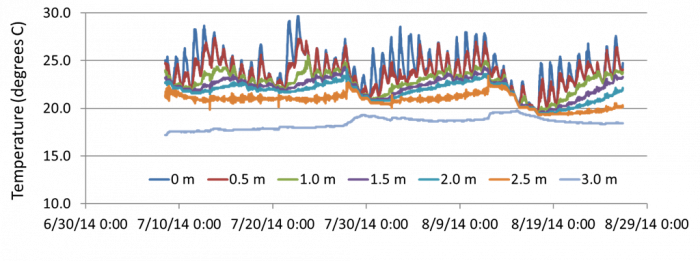
Expected Performance[edit]
- Relative to a surface draw outlet, the expected 95th percentile temperature reduction provided by a 2 m deep draw outlet for years with similar air temperatures is between 3 and 5⁰C.
- Water drained from outlets 2m below the surface will typically be less than 24°C at least 95% of the time.
Night Time Release Outlets[edit]
Employs real time control on pond outlets to automatically close outlets during the day when surface outflow from ponds is warmer, and release water during the night when outflow temperatures are cooler. The outlets are configured and programmed to maintain release rates below threshold values for stream erosion prevention and match pre-development peak flow rates.
Design Considerations[edit]
- Optimal 8 hour duration for night time release outlets was found to be between 3 AM and 10 AM inclusive based on data from 4 ponds
- Optimal 4 hour duration release times were found to be between 6 and 9 AM inclusive (Van Seters and Dougherty, 2019)[7]]].
- Robust automation technology is critical to avoid excessive repairs and down time.
- Electrical supply and back-up power are typically needed at the outlet to reduce operation and maintenance requirements
Expected Performance[edit]
- Based on modelling of four ponds, the 95th percentile temperature reduction for ponds with night time release outlets was calculated to be approximately 1.6⁰C for surface draw outlets, and 0.6⁰C for an outlet 1.4 m below the permanent pool level. For deeper outlets, the benefits of night time release are very small as temperatures from these outlets do not exhibit strong diurnal variations.
Cooling Trenches[edit]
Cooling trenches typically consist of one or more geotextile wrapped perforated pipes embedded in a clear stone filled trench that is buried underground. Water temperatures are reduced through heat transfer from the water passing through the trench to the stone and surrounding soils. Cooling trenches may be installed downstream of the primary pond outlet or draw from a secondary orifice controlled outlet draining water from the pond at or below the permanent pool water level (e.g Van Seters and Graham, 2013[8].; TRCA, 2020[9]). Further information about these innovative cooling trench features installed as part of the stormwater pond operation design in two sites located in Markham, ON. visit the STEP project page. The permanent pool of stormwater management ponds acts as a heat sink during the summer, resulting in warmer summer discharges during both storm and baseflow conditions.
The technology, known as the Groundwater Emulation Management System (GEMS), was designed to maintain cool stream discharge from the SWM pond catchment at a level similar to that experienced prior to development. This is accomplished by draining water at a controlled rate from the permanent pool of a stormwater pond to a cooling/infiltration trench. The cooling trench lowers the temperature of pond water through below ground heat transfer and discharges to the receiving watercourse at a rate and volume mimicking the natural discharge of groundwater. Estimated reductions in groundwater recharge caused by the conversion of land from agriculture and open space to residential use provided the basis for setting continuous flow rates released into the system.
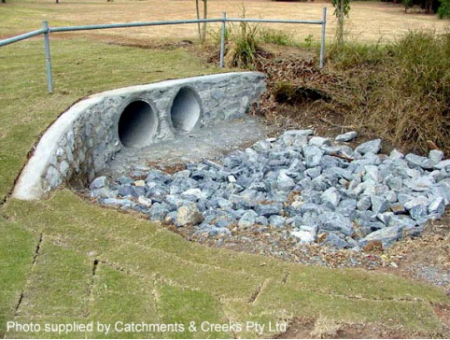
Design Considerations[edit]
- Built-in overflows bypass high flows to help enhance thermal function and prevent excessive sediment build-up in the trench.
- Available research shows that the trench storage volume should be equal to or greater than 5% of the runoff volume discharged from the pond during the 25 mm event. Trenches with smaller storage volumes cannot be relied on to provide any cooling benefits, although under favourable conditions, these may still provide some cooling.
- Flush-out pipes, high flow bypasses and sediment pre-treatment mechanisms should be provided to reduce maintenance.
- Pre-treatment filters, energy dissipators or isolator rows are useful to improve overall functionality but will require regular inspection and maintenance to ensure they are fulfilling their intended function.
- Secondary pond outlets that drain water from 0.5 m below the permanent pool elevation to cooling trenches can help to reduce or eliminate the long duration and very warm interevent flows.
- Trenches may incorporate an infiltration function to help further reduce thermal loads if native soils and groundwater levels are suitable.
Expected Performance[edit]
- Performance of primary outlet cooling trenches is highly variable due to differences in cooling trench sizing, design, initial water temperature and degree of groundwater interaction
- Based on case studies reviewed, primary outlet trenches without groundwater interaction may provide summer temperature cooling of the warmest flows by roughly 1 to 3⁰C if the trench storage volume is equal to or greater than 5% of the runoff volume discharged from the pond during the 25 mm event.
References[edit]
- ↑ Van Seters, T., Graham, C., Dougherty, J., Jacob-Okor, C., and David, Y. 2019. Data Synthesis and Design Considerations for Stormwater Thermal Mitigation Measures. Sustainable Technologies Evaluation Program. Ontario. https://sustainabletechnologies.ca/app/uploads/2019/04/Thermal-Synthesis-Final.pdf
- ↑ Van Seters, T., Graham, C., Dougherty, J., Jacob-Okor, C., and David, Y. 2019. Data Synthesis and Design Considerations for Stormwater Thermal Mitigation Measures. Sustainable Technologies Evaluation Program. Ontario. https://sustainabletechnologies.ca/app/uploads/2019/04/Thermal-Synthesis-Final.pdf
- ↑ Van Seters, T., Graham, C., Dougherty, J., Jacob-Okor, C., and David, Y. 2019. Data Synthesis and Design Considerations for Stormwater Thermal Mitigation Measures. Sustainable Technologies Evaluation Program. Ontario. https://sustainabletechnologies.ca/app/uploads/2019/04/Thermal-Synthesis-Final.pdf
- ↑ Van Seters, T., Graham, C., Dougherty, J., Jacob-Okor, C., and David, Y. 2019. Data Synthesis and Design Considerations for Stormwater Thermal Mitigation Measures. Sustainable Technologies Evaluation Program. Ontario. https://sustainabletechnologies.ca/app/uploads/2019/04/Thermal-Synthesis-Final.pdf
- ↑ Ministry of the Environment. 2003. Stormwater Management Planning and Design Manual. March, 2003. ISBN 0-7794-2969-9. PIBS 4329e. https://dr6j45jk9xcmk.cloudfront.net/documents/1757/195-stormwater-planning-and-design-en.pdf
- ↑ Van Seters, T., Graham, C., Dougherty, J., Jacob-Okor, C., and David, Y. 2019. Data Synthesis and Design Considerations for Stormwater Thermal Mitigation Measures. Sustainable Technologies Evaluation Program. Ontario. https://sustainabletechnologies.ca/app/uploads/2019/04/Thermal-Synthesis-Final.pdf
- ↑ Van Seters, T., Graham, C., Dougherty, J., Jacob-Okor, C., and David, Y. 2019. Data Synthesis and Design Considerations for Stormwater Thermal Mitigation Measures. Sustainable Technologies Evaluation Program. Ontario. https://sustainabletechnologies.ca/app/uploads/2019/04/Thermal-Synthesis-Final.pdf
- ↑ Van Seters, T., Graham, C. 2013. Evaluation of an Innovative Technique for Augmenting Stream Baseflows and Mitigating the Thermal Impacts of Stormwater Ponds. Sustainable Technologies Evaluation Program, Toronto and Region Conservation Authority, Toronto, Ontario. https://sustainabletechnologies.ca/app/uploads/2013/08/Cooling-trench-final-2013a.pdf
- ↑ Toronto and Region Conservation Authority (TRCA) 2020. Evaluation of a Thermal Mitigation System on the Heritage at Victoria Square Pond in Markham. Toronto and Region Conservation Authority, Vaughan, Ontario. https://sustainabletechnologies.ca/app/uploads/2021/01/TM-Heritage-report-2021R.pdf
- ↑ Catchments & Creek Pty Ltd. 2010. Energy Dissipaters, Drainage Control Technique. ED-1.doc. Version 2 - May 2010. International Erosion Control Organization (IECO), Australia. https://www.austieca.com.au/documents/item/307
